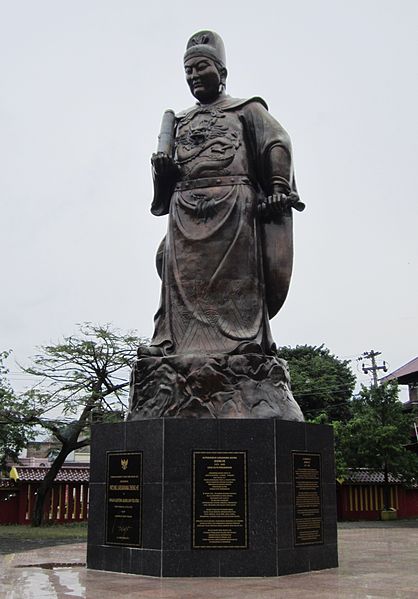During the Ming dynasty, Chinese Emperor Yongle organized a series of naval expeditions in the Indian Ocean basin. The expeditions were led by eunuch admiral Zheng He. He was a Muslin from Yunnan who was the emperor’s trusted adviser. The Ming admiral navigated a fleet of large ships around the globe in seven expeditions from 1405 until 1433 that are unmatched in world history. The expeditions were not only impressive in their size but also in the distance. The emperor organized the expeditions to benefit China as an attempt to impress foreign people of the power and might of the Ming dynasty and to impose imperial control over foreign trade.1
Wanting to impress the Ming power on the world and showing that China had many resources, Emperor Yongle gave orders to construct great baochuan or treasure ships. The ships were enormous in size with nine masts and four decks. The treasure ships were said to be able to accommodate more than 500 passengers and massive amounts of cargo. The ships were supposedly twice as long as any of the European ships that existed at the time, measuring 137 meters long. Also, compared to other ships of the time, the treasure ships were wider in relation to their length at approximately 55 meters wide. The ships’ wideness along with floating anchors casted off the sides of the ship and balanced rudders, which could be raised and lowered helped with the ships’ stability during the expeditions. Lastly, watertight compartments were used to give the treasure ships strength to withstand the long expeditions.2

During Zheng He’s seven voyages to what the Chinese called the “Western Ocean,” which is the Indian Ocean, he brought back many treasures and envoys from far empires. The first voyage was the mighty armada. On July 11, 1405 the fleet left to travel around the Indian Ocean and was comprised of 317 ships with 27,870 men on board. Its first port call was Vijaya, the capital of Champa and then continued onto the island of Java carefully avoiding Chen Zuyi pirates on their way there. It then proceeded to its main stop of Cochin and the kingdom of Calicut. On their return, He defeated Chen Zuyi pirates killing more than 5,000 of them and sinking 10 of their ships. Chen Zuyi and two of his top associates were captured and then beheaded on October 2, 1407. This first voyage increased China’s prestige in the eastern Indian Ocean basin and established a large trading center in Malacca.3
The second voyage was not commanded by He himself, but was organized by him. It was a voyage of 68 ships traveling to Calicut to attend the inauguration of a new king and to return foreign ambassadors from Sumatra, India, and other places that had traveled to China on the first voyage. The third voyage was again commanded by He and traveled to Ceylon. When they arrived at Ceylon, He brought a tablet as a gesture to appease the religious people of Ceylon that praised Buddha, Siva, and Allah. The Ceylon warrior Alakeswara was offended by the tablet, refused to erect it and drove He and his people back to their ships. Zheng He captured Alakeswara and took him back to China.4
The fourth voyage was He’s most ambitious voyage to this point. He made his usual stops, but then proceeded to the Horn of Africa and the Arabian Peninsula. At the end of this voyage, He brought a giraffe back to China. The fifth voyage was marked by the first visit to Africa. The expedition brought back a boatload of African exotic animals, including antelopes, leopards, lions, oryxes, rhinos, ostriches, zebras, and more giraffes. The giraffes were of particular interest to the Chinese as the animal was though to be the mythical creature qilin. Qilins are creatures that are known as Chinese unicorns. The benevolent creature is a cross between a horse and a dragon and its presence is believed to be a promising sign. It is believed that possessing the giraffe that He brought back helped Yongle cement his legitimacy as the second Ming emperor.5
His sixth voyage was his shortest. During this voyage he returned envoys to their home countries. In 1424, Emperor Yongle died, and his successor Xongxi, suspended naval expeditions abroad as he felt that these voyages were a costly waste of money and resources. The new emperor unfortunately only lived nine months after becoming emperor, and his son, Xuande, took over. Xuande sent He on his seventh and final voyage. The final voyage lasted for three years and visited more than fifteen different ports on the way to Kenya. It is believed that the voyage split into two groups when it reached Calicut, and He stayed there due to failing health. Zheng He died in 1433. It is unknown if he died at Calicut or on the voyage back to China.6
Despite the voyages being successful, the voyages were stopped and the ships destroyed after the seventh voyage. The new emperors that took over the country after Yongle’s death, after evaluating the cost of the voyages, believed that the priority needed to be to protect China from Mongol attacks. The voyages, however, before being stopped, returned precious items that benefited the country. By the end of the century, China passed laws that prohibited ships to be built with more than two masts. In 1525, the Chinese government ordered the destruction of all oceangoing ships and the greatest naval fleet in history was dissolved.
- Barbara Bennett Peterson, “The Ming Voyages of Cheng Ho (Zheng He), 1371-1433,” The Great Circle 16, no. 1 (1994): 43. ↵
- Sally K. Church, “Zheng He: An Investigation into the Plausibility of 450-ft Treasure Ships,” Monumenta Serica 53 (2005): 1. ↵
- Encyclopedia Britannica, December 2015, s.v. “Zheng He,” by Jung-Pang Lo. ↵
- Encyclopaedia Britannica, December 2015, s.v. “Zheng He,” by Jung-Pang Lo. ↵
- Encyclopaedia Britannica, December 2015, s.v. “Zheng He,” by Jung-Pang Lo. ↵
- Encyclopaedia Britannica, December 2015, s.v. “Zheng He,” by Jung-Pang Lo. ↵



24 comments
Mario Sosa
People seem to overlook the fact that China had already begun to explore the ocean before Spain or England even dared to try. China had so much potential with such a great advantage in their navy that it was such a shame when they had to end all production of naval exploration. Just imagine how much different the world would be today had they continued to conduct voyages. Thank you for sharing this article; job well done.
Johnanthony Hernandez
Great article, I did not know the Chinese had gone to such lengths to find trade routes and in a sense expand its empire. To show the might of the Ming Dynasty through the use of expeditions was most likely a wise move to show their power without military conquest to show its power. But the idea that over seven voyages the Ming Emperor would send that much man power and that many ships for expeditions astonishes me.
Jennifer Pogue
Amazing article! Without a doubt, Zeng He had the best job in the world. He took numerous voyages to extremely amazing places. Although, it would have been difficult to stay on a ship with so many men and a limited supply of food and water; they must have planned very well. It is very unfortunate that his ships were destroyed and that no one else was able to truly follow in his foot steps.
Ana Gonzalez
This a very detailed article! I had learned that Zhen He embarked on several voyages in order to convey that China was powerful. However, this article provided more detail as to why Zhen He embarked on the journey and what he brought back with him to China like the animals native to Africa. It’s a very interesting article because although Zheng He traveled for the benefit of China, I’m sure other countries also benefited from this cultural diffusion.
Cameron Adelman
I enjoyed this article, given how informative it was and how easy it was to read. It really painted a clear picture of how grandiose and significant these expeditions were (I found the information you included about the extreme size of the Chinese vessels to be particularly interesting).
I am curious to know more specifically what you were referring to when you said that, “The Ming Admiral navigated a fleet of large ships around the globe in seven expeditions from 1405 until 1433 that are unmatched in world history.” What exactly made these voyages superior to, for example, the voyages of European explorers and traders?
Christian Lozano
The article really presents the voyages of Zheng He as mysterious and grandiose. I found particular interest in the fact that a giraffe was brought back to China, I can only imagine how the Chinese felt seeing one of these animals in the flesh for the first time. Definitely a feeling I want to have one day, Great Job on the article.
Jacob Hall
This was an intriguing article. I had no idea how far China had explored around the world, or that they had once sailed the largest naval fleet in history across the Indian and Southern Pacific Oceans. The expanse of their expeditions was impressive, even sailing around the Horn of Africa in later voyages. One can only imagine, had they sailed a bit further west past Africa, they may well have been the first nation to discover the Americas.
Tina Valdez
I found this information extremely interesting! I appreciated the way you organized your article as well, providing details about each one of Zheng He’s Voyages. I cannot imagine what commanding a voyage took, even the organization of the voyages is quite impressive. Zheng He was certainly ambitious in his voyages. It is understandable as to why the voyages were stopped, however this piece of history goes a long way.
Rafael Ortiz Salas
Interesting article. I never heard of the Zheng He before reading this article. It’s fascinating that they used ships that could carry hundreds of people, and their boats were bigger than the Europeans at the moment. Very good and informative article. 🙂
Salvador Rodriguez Gomez
Great article! I found it very easy to follow and it has lots of information in it. One can’t help but wonder what China would be like right now if the new emperor had allowed the voyages to continue.